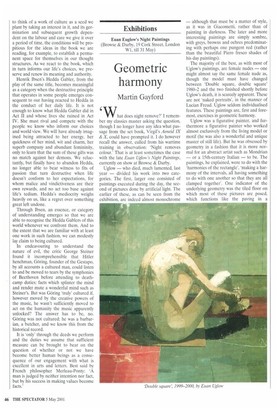Exhibitions
Euan Euglow's Night Paintings (Browse & Darby, 19 Cork Street, London Wl, till 31 May)
Geometric harmony
Martin Gaylord
What does night remove?' I remember my classics master asking the question, though I no longer have any idea what passage from the set book, Virgil's Aeneid IX & X, could have prompted it. I do however recall the answer, culled from his wartime training in observation: 'Night removes colour.' That is at least sometimes the case with the late Euan Uglow's Night Paintings, currently on show at Browse & Darby.
Uglow — who died, much lamented, last year — divided his work into two categories. The first, larger one consisted of paintings executed during the day, the second of pictures done by artificial light. The earlier of these, as can be seen from the exhibition, are indeed almost monochrome — although that must be a matter of style, as it was in Giacometti, rather than of painting in darkness. The later and more interesting paintings are simply sombre, with greys, browns and ochres predominating with perhaps one pungent red (rather than the beautiful Piero fresco shades of his day paintings).
The majority of the best, as with most of Uglow's paintings, are female nudes — one might almost say the same female nude as, though the model must have changed between 'Double square, double square' 1980-2 and the two finished shortly before Uglow's death, it is scarcely apparent. These are not 'naked portraits', in the manner of Lucian Freud. Uglow seldom individualised features. These paintings are, first and foremost, exercises in geometric harmony.
Uglow was a figurative painter, and furthermore a figurative painter who worked almost exclusively from the living model or motif (he was also a wonderful and unique master of still life). But he was obsessed by geometry in a fashion that it is more normal for an abstract artist such as Mondrian — or a 15th-century Italian — to be. The paintings, he explained, were to do with the 'harmonies of the rectangle', 'making a harmony of the intervals, all having something to do with one another so that they are all clamped together'. One indicator of the underlying geometry was the tiled floor on which most of these pictures are posed, which functions like the paving in a cityscape by a Florentine perspectivist.
But part of this harmony was a still life or a living body — or, in the case of 'Tension' 1992-93, two — a body which had to be observed with accuracy. It was not quite squaring that circle, but fitting those curves, harmonically onto a double square — or whatever variety of rectangle it was
— that took the time. And these paintings required an amazing amount of time in some cases, three years for 'Jana' 1996-97, for example, a canvas 14' by 163/4".
I happened to interview Uglow the day it was finished, four years ago — a partial transcript of the resulting conversation is in the current issue of Modem Painters magazine. Or rather, as Uglow corrected, when I used the word finished, shortly after it 'stopped' or 'was broken off (he found the idea of finishing a painting preposterous). That evening, the set-up for 'Jana' was still visible on the ground floor of Uglow's rambling house-cum-studio in a Clapham mews, looking like the vestige of some arcane scientific experiment. There were a light box. plumb line and chalk marks, all to ensure that both Uglow and model were almost in precisely the same positions, the light falling in the same way.
Experiments, in a way, were exactly what Uglow's pictures were. If the model's hip wasn't in precisely the right position — curving down to meet the centre line — it wouldn't, he insisted, be worth painting. Uglow came out of the Coldstream school of drawing, in which constant measurements were made by eye to record the position of every element of the scene under examination. These little marks remain visible in the final painting (that is the sign of the Coldstream school). But in Uglow's work those marks had changed function. They were no longer, as he put it, about 'getting it right', they had become harmonics, vibrations in the air, registering subtle modulations of the basic geometric chord.
All of this — the measurements, the geometry, the glacial speed of work — may sound chilly. Indeed, there are those who find Uglow's work cold. While others consider the careful recording of these young female bodies contorted into Euclidean positions positively kinky. Uglow himself insisted that art was 'no good unless there's passion. . . you can't talk about it. You can't generate passion. It's got to be there.'
His attitude to subject matter could be whimsical, as was shown by 'Nuria', his contribution to the Encounters exhibition at the National Gallery and also in this show. It shows a naked girl bent over a low bench in the attitude — though who would guess?
— of Monet's Japanese bridge. But strange though the process of creation might have been, the result when he succeeded had a crystalline clarity and inevitability of, as he put it, something 'living in itself'.
And Uglow seemed to get better and better, which makes his relatively early death at 68 all the sadder. These Night Pictures seem darker not so much because of the light in which they were painted — Richard Kendall notes in the catalogue that some were actually painted during the day in the gloom of Uglow's living-room. They are dark in mood, reflecting night thoughts as well as paintings at night.











































































 Previous page
Previous page